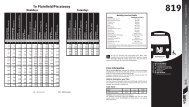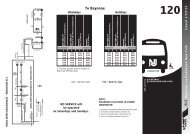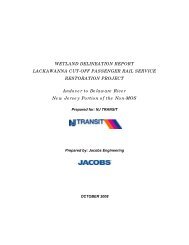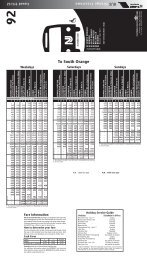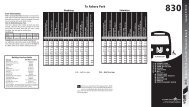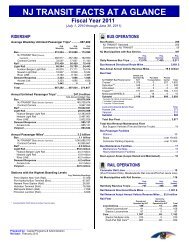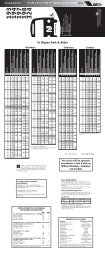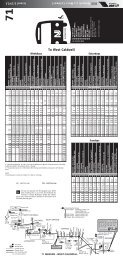APPENDIX L: Endangered Species Technical Report - New Jersey ...
APPENDIX L: Endangered Species Technical Report - New Jersey ...
APPENDIX L: Endangered Species Technical Report - New Jersey ...
Create successful ePaper yourself
Turn your PDF publications into a flip-book with our unique Google optimized e-Paper software.
<strong>New</strong> <strong>Jersey</strong> – Pennsylvania Lackawanna Cut-Off Passenger Rail Service Restoration Project Environmental Assessment FINAL<br />
Department of Environmental Protection Division of Parks and Forestry, Office of Natural Lands<br />
Management, National Heritage Program (NHP) and the <strong>Endangered</strong> and Nongame <strong>Species</strong> Program<br />
(ENSP).<br />
L.1.1 US Department of the Interior - Fish and Wildlife Service<br />
The US Fish and Wildlife Service was contacted on two fronts at both the <strong>New</strong> <strong>Jersey</strong> and Pennsylvania<br />
field offices to identify federally listed threatened or endangered species known to occur within the study<br />
corridor. While no documentation of any of the following species has been recorded in the study corridor<br />
habitat for these species may be present on abandoned portions or adjacent to the right-of-way.<br />
The <strong>New</strong> <strong>Jersey</strong> field office has raised concern over protecting critical habitat for Bog turtle (Clemmys<br />
muhlenbergii), federally threatened, NJ endangered and the Indiana bat (Myotis sodalis) federally<br />
endangered, NJ endangered. The Pennsylvania field office has raised the same concerns over critical<br />
habitat for both Bog turtle and Indiana bat however included Bald Eagle (Haliaeetus leucocephalus)<br />
federally endangered, PA endangered and the Northeastern Bulrush (Scirpus ancistrochaetus) federally<br />
endangered. Descriptions for each of these species can be found below.<br />
Bog Turtle<br />
The Bog Turtle population is divided into two geographically isolated populations, a southern and a<br />
northern segment divided by nearly 250 miles. The northern populations occur in Connecticut, Delaware,<br />
Maryland, Massachusetts, <strong>New</strong> <strong>Jersey</strong>, <strong>New</strong> York and Pennsylvania. Within the project corridor, the Bog<br />
Turtle is known to occur in Monroe and Northampton Counties in Pennsylvania and in Warren, Sussex,<br />
and Morris Counties in <strong>New</strong> <strong>Jersey</strong>.<br />
The northern population has declined nearly 50 percent within the last 20 years. The majority of this<br />
decline has been a result of habitat destruction. Hydrological alteration of the Bog Turtle’s habitat has<br />
been a byproduct of draining, ditching, dredging, filling and flooding of wetlands for residential, urban<br />
and commercial development; road construction; agricultural use; pond and reservoir construction.<br />
Illegal collection for national and international pet trade has also reduced the population.<br />
The carapace (upper shell) measures 3 to 4.5 inches in length and ranges in color from light brown to<br />
ebony. It has a large, conspicuous bright blotch found on each side of the head varying in color from<br />
yellow to red. The plastron (lower shell) is brownish-black with contrasting yellow and cream areas. The<br />
species is sexually dimorphic.<br />
Bog turtles inhabit shallow, spring-fed fens, sphagnum bogs, swamps, marshy meadows and pastures<br />
characterized by soft, muddy bottoms. There is cool, clear, slow flowing water that often forms a<br />
network of rivulets and generally high humidity with an open canopy.<br />
The wetland habitat is usually a mosaic of microhabitats ranging from dry pockets to areas that are<br />
saturated by water to areas that are periodically flooded. They use shallower water areas in the warm<br />
weather and retreat to deeper waters in the winter. Open-canopy wetlands are slowly being invaded by<br />
woody vegetation as the natural succession into a wooded swampland with a closed-canopy occurs.<br />
Some wetlands are grazed by livestock which can compact the mucky bottom that the turtles prefer, but it<br />
helps to keep out successional species that ultimately close the canopy and fill the muck substrate. Heavy<br />
grazing will destroy the habitat.<br />
NJ TRANSIT June 2008<br />
L-2




